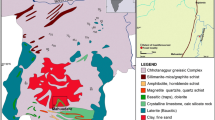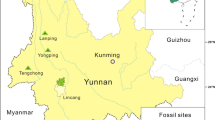Abstract
Three species of Palaeocarya were found from the Oligocene Ningming Formation of Guangxi, South China. Two species have been identified, Palaeocarya guangxiensis and Palaeocarya ningmingensis, and a new species is described, Palaeocarya longipedicelata J.L. Dong et B.N. Sun sp. nov. The new species is diagnosed primarily by a distinct long pedicel of 8.0–10.0 mm in length, lobe base tri-veined, upper pinnate venation with retuse apex, small prophyllum, and nutlet without hair. The epidermal cells show obscure polygons with undulated cell walls from the tri-lobed bract and show clear polygons with straight cell walls from the pedicel. The peltate scales and circular peltate trichomes are also observed. The occurrence of these winged fruit fossils from the Oligocene suggests that Palaeocarya began to diversify no later than the Oligocene in Guangxi, South China. From the correlation between present fossils with previously published fossils from the Oligocene Jilin, Northeast China, it can be inferred that Palaeocarya had a wide distribution during the Oligocene in China, ranging from the south to the northeast. Based on the analysis of the ecological requirements of the extant relative species, Engelhardia, Alfaropsis and accompanying plant and fungi fossils, we can infer that the palaeoclimate of the Ningming region should be considered a warm and humid tropical–subtropical climate. Finally, we speculate that the Ningming Basin during the Oligocene was close to the low-latitude mountains.
Kurzfassung
Drei Arten von Palaeocarya wurden in der oligozänen Ningming-Formation in Guangxi (S-China) gefunden. Zwei Arten wurden identifiziert, Palaeocarya guangxiensis und Palaeocarya ningmingensis, wie auch eine neue Art (Palaeocarya longipedicelata J.L. Dong et B.N. Sun sp. nov.) beschrieben wird. Die neue Art wurde primär anhand des langen, ausgeprägten Pedicellus mit einer Länge von 8.0–10.0 mm, der dreiaderigen Basis der Loben, der oben gefiederten Aderung mit gestutztem Apex, dem kleinem Vorblatt und der kleinen, haarfreien Nuss festgelegt. Die Epidermalzellen weisen ein undeutliches Polygon mit undulierenden Zellwänden des dreiaderigen Deckblatts und deutliche Polygone mit geraden Zellwänden des Pedicellus auf. Peltate Schuppen und runde, peltate Trichome wurden ebenfalls festgestellt. Dieses Fossilvorkommen geflügelter Früchte aus dem Oligozän belegt den Beginn der Diversifizierung von Palaeocarya spätestens im Oligozän des südchinesischen Guangxi. Ein Vergleich zwischen den vorliegenden Fossilien mit früher publizierten Funden aus dem Oligozän von Jilin (NE-China) ermöglicht den Rückschluss, dass Palaeocarya eine weite Verbreitung während des Oligozäns in China aufwies, vom Süden bis zum Nordosten. Aus der ökologischen Analyse heutiger verwandter Arten wie Engelhardia und Alfaropsis nebst begleitenden Pflanzen- und Pilzfossilien können wir schließen, dass das Paläoklima der Ningming-Region ein warmes, humides, tropisch–subtropisches Klima war. Wir vermuten, dass das Ningming-Becken während des Oligozäns an äquatornahe Berge grenzte.







Similar content being viewed by others
References
Akhmetyev, M.A., and G.M. Bratzeva. 1973. Fossil remains of the genus Engelhardtia from Cenozoic deposits of Sikhote-Alin and Southern Primorye. Rev Palaeobot Palynol 16: 123–132.
Bertini, A., and E. Martinetto. 2008. Messinian to Zanclean vegetation and climate of northern and central Italy. Boll Della Soc Paleontol Ital 47: 105–121.
Blokhina, N.I. 2004. On some aspects of systematics and evolution of the Engelhardioideae (Juglandaceae) by wood anatomy. Acta Palaeontol Rom 4: 13–21.
Brown, R.W. 1959. A bat and some plants from the Upper Oligocene of Oregon. J Paleontol 33: 125–129.
Chen, G.J., and M.M. Chang. 2011. A new early cyprinin from Oligocene of South China. Sci China Earth Sci 54(4): 481–492.
Chen, Y.F., S.R. Manchester, Z.Q. Song, and H.S. Wang. 2014. Oligocene fossil winged fruits of tribe Engelhardieae (Juglandaceae) from the Ningming Basin of Guangxi Province, South China. Int J Latest Res Sci Technol 3(5): 13–17.
Chen, Y.F., and D.X. Zhang. 2005. Bauhinia larsenii, a fossil legume from Guangxi, China. Bot J Linn Soc 147: 437–440.
Crepet, W.L., and D.L. Dilcher. 1977. Investigations of angiosperms from the Eocene of North America: a mimosoid inflorescence. Am J Bot 64: 714–725.
Dilcher, D.L., F.W. Potter, and W.L. Crepet. 1976. Investigations of angiosperms from the Eocene of North America: Juglandaceous winged fruits. Am J Bot 63: 532–544.
Dilcher, D.L., and S.R. Manchester. 1986. Investigations of angiosperms from the Eocene of North America: leaves of the Engelhardieae (Juglandaceae). Bot Gard 147: 189–199.
Dong, J.L., B.N. Sun, F.J. Ma, Q.J. Wang, P.H. Jin, W.J. Wang, P. Deng, Y. Yang, and X.J. Li. 2015. Paliurus fruits from the Oligocene of South China and their phytogeographic implications. Plos One 10: 1–12.
Fischer, T.C., and R. Butzmann. 2006. The Pliocene macro and microflora of lacustrine sediments from Meleto (Valdarno, N. Italy) and its ecological, palaeobiogeographical and climatic interpretation. Cainozoic Res 5: 71–88.
Guo, S.X., and G.F. Zhang. 2002. Oligocene Sanhe flora in Longjing county of Jilin, northeast China. Acta Palaeontol Sin 41: 193–210.
Iljinskaya, I.A. 1993. Alfaropsis—a new genus of the Juglandaceae. Bot Zhurnal 78: 79–83. (In Russian).
Iljinskaja, I.A. 1990. On the systematics and phylogeny of the family Juglandaceae. Bot Zhurnal 75(6): 702–803.
Jähnichen, H., W.L. Friederick, and M. Takác. 1984. Engelhardioid leaves and fruits from the European Tertiary, part II. Tert Res 6: 109–134.
Jin, J.H. 2009. Two Eocene fossil fruits from the Changchang Basin of Hainan Island, China. Rev Palaeobot Palynol 153: 150–152.
Kuang, K.Z., and A.M. Lu. 1979. Juglandaceae. Delectis florae reipublicae popularis sinicae Agendae academiae sinicae edita, Flora reipublicae popularis sinicae, tomus 21. Beijing: Science Press. 11–18.
Kuang, G.D., G.J. Chen, Y.F. Chen, and Z.T. Huang. 2004. New information on the Tertiary biostratigraphy of the Ningming Basin, Guangxi. J Stratigr 28: 362–367. (in Chinese with an abstract in English).
Lu, A.M. 1982. On the geographical distribution of the Juglandaceae. Acta Phytotaxon Sin 20: 257–274. (in Chinese with an abstract in English).
Lu, A.M., D.E. Stone, and L.J. Grauke. 1999. Juglandaceae. In Flora of China, ed. Z.Y. Wu, P.H. Raven, and D.Y. Hong, 278–280. Beijing: Science Press.
Li, H.M., Y.F. Chen, G.J. Chen, G.D. Kuang, and Z.T. Huang. 2003. Tertiary fossil winged fruits of Palaeocarya from Ningming of Guangxi, S. China. Acta Palaeontol Sin 42: 537–547. (in Chinese with an abstract in English).
Manchester, S.R. 1981. Fossil history of the Juglandaceae. Ph.D. thesis, Indiana University, Bloomington.
MacGinitie, H.D. 1941. A Middle Eocene flora from the central Sierra Nevada. Carnegie Institute of Washington Publication 534: 1–178.
MacGinitie, H.D. 1969. The Eocene Green River flora of northwestern Colorado and northeastern Utah. University of California Publications in Geological Sciences 83:1–140.
Manchester, S.R. 1987. The fossil history of the Juglandaceae. United States: Monographs in Systematic Botany from the Missouri Botanical Garden.
Manchester, S.R. 1989. Early history of the Juglandaceae. Plant Syst Evol 162: 231–250.
Manchester, S.R. 1983. Fossil wood of the Engelhardieae (Juglandaceae) from the Eocene of North America: Engelhardioxylon gen. nov. Bot Gaz 144: 157–163.
Manchester, S.R., M.E. Collinson, and K. Goth. 1994. Fruits of the Juglandaceae from the Eocene of Messel, Germany, and implications for early Tertiary phytogeographic exchange between Europe and west North America. Int J Plant Sci 155: 388–394.
Manning, W.E. 1978. The classification within the Juglandaceae. Ann Mo Bot Gard 65: 1058–1087.
Manos, P.S., and D.E. Stone. 2001. Evolution, phylogeny, and systematics of the Juglandaceae. Ann Mo Bot Gard 88: 231–269.
Manos, P.S., P.S. Soltis, D.E. Soltis, S.R. Manchester, S.H. Oh, C.D. Bell, D.L. Dilcher, and D.E. Stone. 2007. Phylogeny of extant and fossil Juglandaceae inferred from the integration of molecular and morphological data sets. Syst Biol 56: 412–430.
Meng, H.H., T. Su, Y.J. Huang, H. Zhu, and Z.K. Zhou. 2015. Late Miocene Palaeocarya (Engelhardieae: Juglandaceae) from Southwest China and its biogeographic implications. J Syst Evol 9999(9999): 1–13.
Ma, F.J., B.N. Sun, Q.J. Wang, J.L. Dong, G.L. Yang, and Y. Yang. 2015. A new species of Meliolinites associated with Buxus leaves from the Oligocene of Guangxi, South China. Mycologia. doi:10.3852/14-270.
Nichols, D.J. 1973. North American and European species of Momipites (“Engelhardtia”) and related genera. Geosci Man 7: 103–117.
Stone, D.E. 2010. Review of New World Alfaroa and Old World Alfaropsis (Julgandaceae). Novon 20: 215–224.
Saporta, G. 1873. Études sur la vegetation du sud-est de la France a l’époque Tertiaire. Suppl. I: Revisionde flore des gypses d’Aix. Ann des Sci Nat Bot 5: 81–244.
Shi, G.L., Z.Y. Zhou, and Z.M. Xie. 2010. A new Cephalotaxus and associated epiphyllous fungi from the Oligocene of Guangxi, South China. Rev Palaeobot Palynol 161: 179–195.
Shi, G.L., Z.Y. Zhou, and Z.M. Xie. 2011. Cupressus foliage shoots and associated seed cones from the Oligocene Ningming Formation of Guangxi, South China. Rev Palaeobot Palynol 166: 325–334.
Shi, G.L., Z.Y. Zhou, and Z.M. Xie. 2012. A new Oligocene Calocedrus from South China and its implications for transpacific floristic exchanges. Am J Bot 99: 108–120.
Shi, G.L., Z.M. Xie, and H.M. Li. 2014. High diversity of Lauraceae from the Oligocene of Ningming, South China. Palaeoworld 23: 336–356.
Song, Z.Q., G.L. Shi, Y.F. Chen, and Q. Wang. 2014. Winged fruits of Ailanthus (Simaroubaceae) from the Oligocene Ningming Formation of Guangxi, and their taxonomic and biogeographic implications. Acta Palaeontol Sin 53(2): 191–200.
Sun, B.N., D.F. Yan, S.P. Xie, and Y.D. Wang. 2009. Stomata and carbon isotope analyses of fossil plants and their application. Beijing: Science Press.
Stone, D.E. 1972. New Juglandaceae, III. A new perspective of the tropical members with winged fruits. Ann Mo Bot Gard 59: 297–321.
Tanai, T., and K. Uemura. 1983. Engelhardia fruits from the tertiary of Japan. J Fac Sci Hokkaido Univ Ser IV 20: 249–260.
Wang, Q., Z.Q. Song, Y.F. Chen, S. Shen, and Z.Y. Li. 2014. Leaves and fruits of Bauhinia (Leguminosae, Caesalpinioideae, Cercideae) from the Oligocene Ningming Formation of Guangxi, South China and their biogeographic implications. BMC Evol Biol 14: 1–16.
Wang, W.M., G.J. Chen, Y.F. Chen, and G.D. Kuang. 2003. Tertiary palynostratigraphy of the Ningming Basin, Guangxi. J Stratigr 27: 324–327. (in Chinese with an abstract in English).
Wang, Q.J., F.J. Ma, J.L. Dong, Y. Yang, P.H. Jin, and B.N. Sun. 2015. Coryphoid palms from the Oligocene of China and their biogeographical implications. Comptes Rendus Palevol. doi:10.1016/j.crpv.
Xie, S.P., B.N. Sun, D.L. Dilcher, D.F. Yan, J.Y. Wu, and Z.C. Lin. 2010. Numerical taxonomy of Palaeocarya (Juglandaceae) from the Mangbang Formation of West Yunnan, China. Rev Palaeobot Palynol 162: 193–202.
Acknowledgments
We are grateful to Dr. San-Ping Xie (Lanzhou University, China) for providing important literature and valuable suggestions. We also thank South China Botanical Garden for the permission to collect extant specimens, Jun-Lin Chen and Rui-Yun Li (Lanzhou University, China) for the help in drawing and writing. This work was conducted under the National Natural Science Foundation of China (No. 41172022), Specialized Research Fund for the Doctoral Program of Higher Education (Grant No. 20120211110022), the National Basic Research Program of China (973 Program) (2012CB822003), and Research Funds for the Central Universities (No. lzujbky-2015-201).
Author information
Authors and Affiliations
Corresponding author
Rights and permissions
About this article
Cite this article
Dong, JL., Wang, WJ., Deng, P. et al. New material of Palaeocarya from the Oligocene of Ningming, Guangxi, South China. PalZ 90, 399–412 (2016). https://doi.org/10.1007/s12542-016-0302-z
Received:
Accepted:
Published:
Issue Date:
DOI: https://doi.org/10.1007/s12542-016-0302-z




